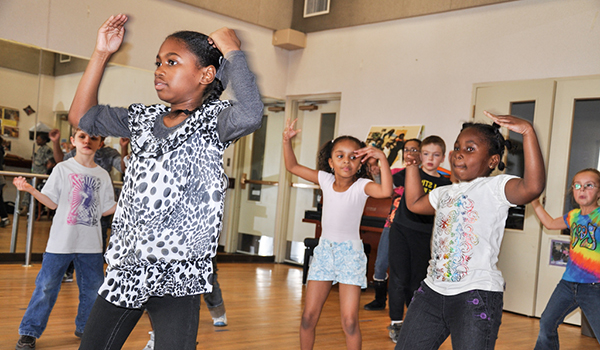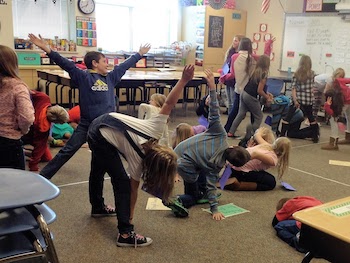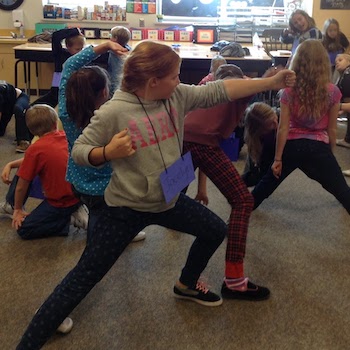SUBJECTS
GRADE
Show Results
Rocks

Lesson Summary
- Recall facts in tandem with a dance about different kinds of rocks.
- Create dance sequences to represent different kinds of rocks.
Lesson Plan and Procedure
Lesson Key Facts
- Grade(s): 2
- Subject(s): Dance, Science
- Duration of lesson: 45 minutes
- Author(s): Jana Shumway
Note: This lesson will be primarily taught through narrative. After giving the narration, you will need to guide the students through a movement experience, as shown below.
Experience/Identify
Play the song “Little Blond in the Park of Attractions“ by Tangerine Dream.
Teacher: Rocks are millions and millions of years old, and all rocks are made of minerals. There are three classifications of rocks.
Activity 1: Sedimentary Rocks
Teacher: One type of rock is called sedimentary. Sedimentary rocks are found all over the earth’s surface.
Have the students dance around the room, trying to dance in spaces that are not being used by someone else.

Have the students make small rock shapes. They can be curved, pointed, angled, jagged, and so on.
Teacher: These small sediments are cemented together to create the rock.
Have all of the students remain in their previous shape and scoot close together to create one large group.
Teacher: When we look at sedimentary rocks, we often see many layers.
Split the class in two groups (option: boys and girls). Have each group create a layered shape (blonde lowest, brunette middle, black or red hair highest level, and so on). Have them make these shapes long, flat, and layered.
Teacher: Sedimentary rocks are the most common rocks in which to find fossils.
Select one student in each group to create a fossil shape in the middle of the layered shape. Have the rest of the students chisel away from the fossil by performing sharp staccato movements that get lower and lower to the ground. This will reveal the fossil.
Activity 2: Igneous Rocks
Teacher: A second rock classification is igneous. Igneous rocks are made from magma, which is found deep under the earth and inside volcanoes.
Have the students travel around the room performing smooth, curving, and flowing movement. Encourage them to swirl, without touching, around the other students.
Teacher: Magma increases in heat until finally a volcano erupts.
Have the students pretend to bubble up and then do three different explosions.
Teacher: When a volcano erupts, the magma turns into lava, which then flows down the side of the volcano.
Have the students start on one side of the room in a high shape, then walk slowly across the room, getting lower and slower as they get further across.
Teacher: Eventually, the lava cools and hardens as it turns into igneous rock.
Have the students form a frozen shape.
Teacher: Igneous rocks do not come in layers like sedimentary rocks.
Have the students form rock shapes with two or three other students. Emphasize that they are not making layers with this shape.
Teacher: And they often do not have observable crystals.
Have the students’ shapes look a little bit more dull by having their shapes melt or wilt a little.
Teacher: Instead, they can have air holes.
Have the students separate and dance around the room, trying to make big holes themselves by spreading their arms or legs, arching their backs, or circling.
Teacher: Their surfaces are often glass-like.
Have the student move very smoothly and at the same speed (sustained).
Activity 3: Metamorphic Rocks
Teacher: The last rock classification is metamorphic. Metamorphic rocks are made from sedimentary, igneous, or other metamorphic rocks.
Have the students create a variety of big or small, jagged or smooth, angled or curved rock shapes.
Teacher: They are formed by heat and pressure deep within the earth.
Have the students find a partner. Have one partner create a rock shape while the other partner moves frantically around him or her to represent heat, sometimes taking his or her hands and pretending with the movements to be pushing the rock (do not actually touch).

Have the students switch roles. The “frozen” partner now does the heat and pressure dance and the “heat and pressure” partner creates a shape.
Teacher: Then over time, more heat and pressure continue to affect the rock and a complete change can take place again.
Have the students switch roles. The “frozen” partner now does the heat and pressure dance and the “heat and pressure” partner creates a shape.
Teacher: This cycle continues as more and more metamorphic rocks form.
Have the student in the shape drastically change his or her shape to something that looks the opposite (from low to high, from square to circular, and so on).
Teacher: Metamorphic rocks have observable crystals.
Have students do “sparkly” dancing by flickering their fingers while dancing all around the room, performing leaps, spins, and jumps.
Teacher: Notice the banding. Banding occurs when minerals attract to each other, causing the rock to have a layered appearance.
Have the students create one large group that contains layers that stretch on a continuous horizontal line.
Explore/Investigate
Repeat the dances at least three more times. The students will begin to memorize the sequence of the movement as well as the narration that goes along with the movement.
Create/Perform
Invite another fourth-grade class to watch your dance. Have the students (or just yourself) say the narration as the students perform the dance for their peers.
Connect/Analyze
Show the students pictures of the different kinds of rocks.
Point out things in the pictures that they danced through.
Have the students recall facts about the rocks and point them out in the pictures. (For example, have the students find the layers in the sedimentary rocks.)
Learning Objectives
- Identify minerals and rocks.
- Compare and contrast differences in types of rocks.
- Create a dance on a particular topic.
- Recall movement sequences with a partner.
- Replicate movement sequences.
Utah State Board of Education Standards
This lesson can be used to meet standards in many grades and subject areas. We will highlight one grade’s standards to give an example of application.
Grade 2 Science with Engineering Education (SEEd)
- Standard 2.3.1: Plan and carry out an investigation to classify different kinds of materials based on patterns in their observable properties. Examples could include sorting materials based on similar properties such as strength, color, flexibility, hardness, texture, or whether the materials are solids or liquids. (PS1.A)
Grade 2 Dance
- Standard 2.D.CR.2: Explore movement inspired by a variety of stimuli.
- Standard 2.D.CR.4: Reflect on movement choices and change movement through guided improvisational experiences or short remembered sequences.
- Standard 2.D.P.1: Move safely in general space through a range of activities and group formations while maintaining personal space.
Equipment and Materials Needed
Additional Resources
ignore
Image References
Image 1: "Pint-size Zumba offered" by USAG-Humphreys licensed under CC BY 2.0
Images 2–4: BYU Arts Bridge Student Blogs (http://education.byu.edu/arts/bridge/2016).

www.education.byu.edu/arts/lessons
 Download
Download